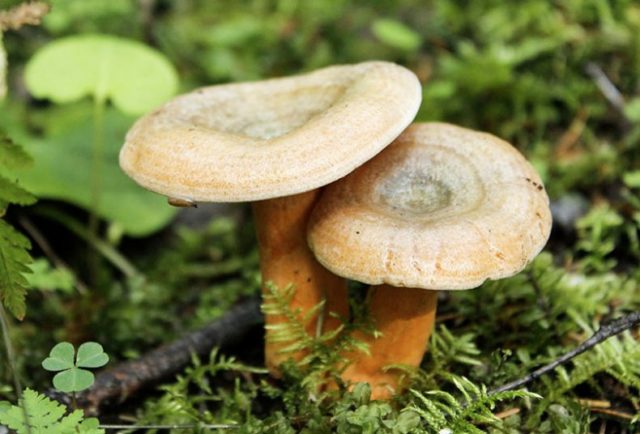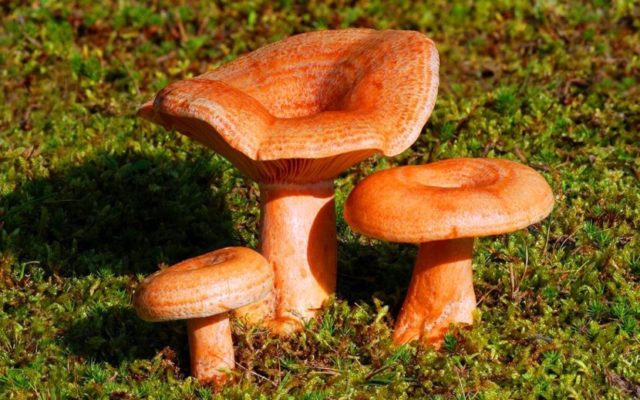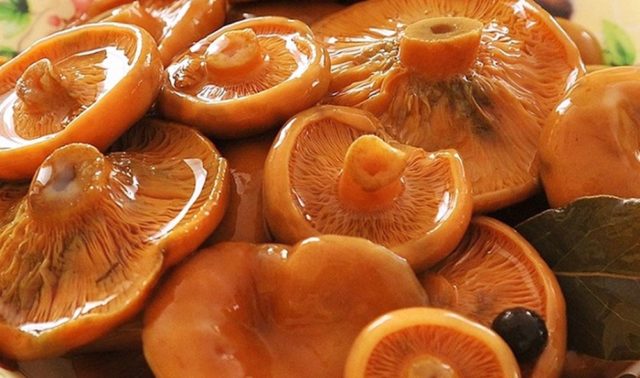Content
Spruce mushroom is a mushroom from the Syroezhkov family, which is also called spruce and is considered one of the delicious mushroom species. To appreciate the taste and benefits of a spruce tree, you need to know how it looks and where it grows.
Where does the spruce mushroom grow
Spruce trees can be found throughout central Russia, as well as in the Urals, the Far East and Siberia. As the name implies, fungi grow in spruce forests, they usually hide in the grass and fallen needles under spruces and sometimes under junipers. Sometimes you can see spruce trees one by one, but more often they are found in whole groups.
Spruce green mushrooms are considered late mushrooms, the maximum fruiting occurs in September, and fungi can be found in the forest until frost.
What does a spruce mushroom look like?
The spruce fungus can be recognized by its flat-concave cap, about 10 cm in diameter, with an auburn or light pink coloration. In young fungi, the cap is slightly convex, with the edges bent down and a tubercle in the middle, but subsequently its shape gradually changes. A characteristic feature of the spruce mushroom is the fragility of the cap and the absence of pubescence at the edges.
According to the photo and description of the spruce mushroom, its leg is small - only about 5 cm in height, shorter than that of a real mushroom. The shape of the stem is cylindrical, in young mushrooms it is whole, and in adults it is hollow from the inside and very brittle. In color, the leg is exactly the same as the hat, and it turns green just as well if it is damaged.
When broken, the spruce fungus releases a bright orange milky sap that quickly turns green from interaction with air. The same goes for the orange pulp, it turns green at the break. From below, the spruce's cap is covered with fragile thin plates of light orange color, which turn green when pressed.
Is it possible to eat spruce mushrooms
In Europe, the spruce camelina mushroom is considered a delicacy and is part of many complex and expensive dishes. Experienced Russian mushroom pickers also agree that spruce mushroom even surpasses the real one in taste and benefit, and requires minimal processing and is definitely suitable for consumption.
Mushroom taste
From the point of view of taste, spruce trees belong to the prestigious 1st category of edible mushrooms. They have a pleasant taste and light fruity aroma when fresh.
Spruce fungi can be processed in almost all existing ways, they are not suitable only for drying. But they are salted, pickled, boiled and fried, and sometimes even eaten fresh, washed and properly sprinkled with salt.
Benefits and harm to the body
Spruce mushrooms, when consumed, are not only able to please with a pleasant taste, they bring significant benefits to the body.
- The spruce trees contain high quality natural protein. Due to it, fungi fully satisfy the body's needs for protein and can successfully replace meat in a vegetarian diet.
- The calorie content of spruce fungi does not exceed 18 kcal per 100 g of raw fungi. When using eloviks, it is impossible to get better, which means that you can eat fungi on a diet.
- Camelina contains a huge amount of vitamin A, it protects the organs of vision from diseases, helps fight inflammation and accelerates wound healing.
- Vitamins B and C in saffron milk caps are responsible for the normal functioning of the metabolic and immune systems in the human body. Eating eloviki is useful for the prevention and treatment of colds, for the normalization of digestion.
- Spruce fungi contain lactariovilin, an antibiotic substance that suppresses pathogenic bacteria. Therefore, it is possible to eat fungi for any infectious processes in the body - mushrooms are beneficial even for tuberculosis.
Fungi contain a sufficient amount of fiber. Elovik can be consumed in order to regulate the bowel movement.
Despite the great benefits, spruce fungi can be harmful in some situations. They are not recommended for use in food:
- with chronic liver diseases;
- with gallstone disease or in the absence of the gallbladder;
- with a tendency to muscle weakness;
- with frequent constipation;
- if you are allergic to mushrooms or the components present in them.
It is not recommended to eat eloviki during pregnancy and lactation - mushrooms can be harmful. It is better not to offer spruce mushrooms to children and the elderly - the product may be too heavy for their digestion.
Differences between spruce and pine mushrooms
According to the photo and description, the spruce mushroom is very similar to its brother - pine, or real, mushroom. They are related by the same structure of the leg and cap, both mushrooms grow mainly in coniferous forests, and they are similar in taste.
But at the same time, with experience, spruce and pine camelina can be distinguished from each other.
- The spruce mushroom forms a symbiosis with spruces and, in some cases, with junipers. Pine grows under pine trees and is usually less visible in grass and fallen needles.
- The cap of the pine mushroom is slightly pubescent; vague large circles, diverging in diameter, are noticeable on it. In the spruce tree, these circles are smaller and less pronounced, and the cap is devoid of edges and in damp weather is often covered with mucus.
- Real mushroom is denser, while spruce is more fragile. At the break, the flesh of both mushrooms turns green, but in the spruce fungus, the color change is faster.
As for the taste, it is the pine mushroom that is officially called a delicacy. However, many connoisseurs of mushrooms are of the opinion that spruce mushrooms are much tastier both fresh and processed.
False doubles
It is rather difficult to confuse mushrooms with poisonous mushrooms - not a single toxic mushroom has a high similarity with spruce trees. However, there are several edible mushrooms with a similar structure and color.
Real mushroom
Most often, spruce trees are confused with pine mushrooms; in appearance and distribution, the fungi are most similar. Pine mushrooms are red-orange in color, similar in size to spruce trees and similar in taste. They can be distinguished mainly by their shade, pubescent cap and less brittle structure.
Red mushroom
In structure and shape, the fungus is similar to pine and spruce, but differs from them in the large size of the cap, up to 16 cm in diameter, and in bright red color. The juice secreted by the fungus at the fracture is also deep red. You can also recognize the fungus by the absence of diverging circles on the cap.
Red fungi are suitable for human consumption, but their taste is much lower than that of eloviks.
Pink wave
Like a young spruce mushroom, the wave has a flat-concave cap and a light pink color.The easiest way to distinguish a mushroom is by the milky juice - it is white at the wave and does not darken under the influence of air. Spruce mushroom, unlike her, releases orange juice, and it quickly turns green in the air.
Collection rules
You can meet the first spruce mushrooms in July, but the bulk of spruce mushrooms appear in September and October. Especially many of these mushrooms grow after a rainy summer, and they can be collected in the forest until frost.
Most often, spruce mushrooms are found in whole groups in young spruce forests and on forest edges. It is rather difficult to notice inconspicuous fungi in fallen leaves and needles, so experienced mushroom pickers recommend taking a long stick with you for a mushroom hike. With this stick, you can gently stir up the needles near the trees, and if you manage to find at least one fir tree, then you can be sure that others are located nearby.
How to cook spruce mushroom
Delicacy spruce mushrooms are prepared in all ways, except for drying. In boiled form, they can be added to salads and side dishes, sometimes mushrooms are even eaten raw, generously sprinkled with salt. But more often the fungi are pickled, fried or salted.
How to pickle spruce mushrooms
In order to marinate the spruce, you first need to prepare the marinade itself. They do it like this:
- pour water into a saucepan and put a small peeled head of garlic, 10 black peppercorns and herbs to taste;
- the ingredients are poured with 5 large tablespoons of vegetable oil;
- the marinade is boiled for 10 minutes over low heat.
At the same time, 1 kg of peeled and washed spruce mushrooms is poured with water in another saucepan so that the liquid covers them completely, and put on fire for half an hour. When the fungi are cooked, you will need to drain the water immediately, and pour the mushrooms into a colander to drain the remaining liquid.
Boiled mushrooms are placed in a glass jar, poured on top with warm spicy marinade, and then tightly closed with a lid. Store pickled spruce mushrooms in a cool place away from sunlight.
How to salt spruce mushrooms
One of the simplest processing recipes is the salting of spruce mushrooms. The process looks like this:
- fresh mushrooms are cleaned of adhered forest debris and wiped with a clean cloth - it is not necessary to wash the fungi;
- in a large container, the mushrooms are laid in a dense layer several centimeters thick and generously sprinkled with a large amount of salt;
- put another layer of mushrooms on top, add salt again, so the layers alternate until the container is full.
Then the container is covered with a lid, pressed down with a heavy object and wait several days until the mushrooms settle, after which a new layer of saffron milk caps and salt is added. When the container is filled to the top, and the fungi stop settling, they can be seasoned with vegetable oil and garlic, black pepper and herbs can be added to the salted spruce mushrooms to taste. You can use salted mushrooms as part of a salad, or you can add them to soup or to main courses.
How to fry spruce mushrooms
In addition to pickling and salting, fungi are often fried, for example, they are very tasty with potatoes and onions. A simple recipe for frying fir trees looks like this:
- about 700 g of fresh spruce mushrooms are washed, cut into small pieces and boiled for half an hour in salted water;
- the ready-made mushrooms are thrown into a colander and the water is drained, and then the mushrooms are temporarily set aside;
- 500 g of potatoes are peeled, washed and cut into small bars;
- peel and cut into half rings 300 g of onions;
- boiled fungi are spread in a preheated pan greased with vegetable oil;
- the mushrooms are fried without covering the pan with a lid until excess moisture evaporates from the mushrooms;
- after that, pour the onion into the pan and fry it together with the mushrooms until a golden hue appears on the half rings;
- at the last stage, add a little more fresh oil to the pan and add the potatoes.
The mixture is fried, stirring regularly, until the potatoes are fully cooked. 5 minutes before the dish is ready, mushrooms and potatoes should be lightly salted and pepper to your liking.
Conclusion
Spruce mushroom is a delicious and valuable mushroom for health, which is rightfully considered a delicacy in many countries. It is found in the autumn forest quite often, and you can cook a wide variety of dishes from it.
















